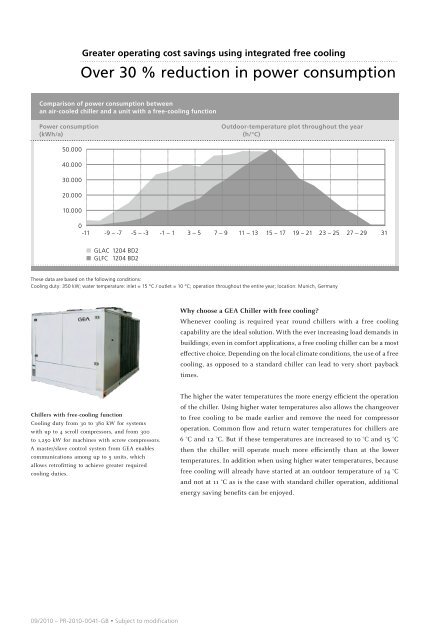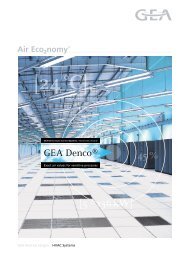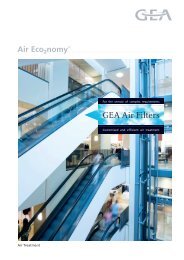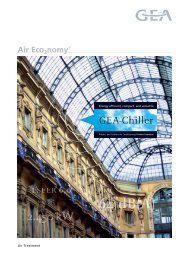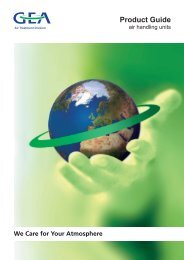GEA Ultra-Denco ® - Deltagci.com
GEA Ultra-Denco ® - Deltagci.com
GEA Ultra-Denco ® - Deltagci.com
You also want an ePaper? Increase the reach of your titles
YUMPU automatically turns print PDFs into web optimized ePapers that Google loves.
Greater operating cost savings using integrated free coolingOver 30 % reduction in power consumptionComparison of power consumption betweenan air-cooled chiller and a unit with a free-cooling functionPower consumption(kWh/a)Outdoor-temperature plot throughout the year(h/°C)50.00040.00030.00020.00010.0000-11 -9 – -7 -5 – -3 -1 – 1 3 – 5 7 – 9 11 – 13 15 – 17 19 – 21 23 – 25 27 – 29 31■ GLAC 1204 BD2■ GLFC 1204 BD2These data are based on the following conditions:Cooling duty: 350 kW; water temperature: inlet = 15 °C / outlet = 10 °C; operation throughout the entire year; location: Munich, GermanyWhy choose a <strong>GEA</strong> Chiller with free cooling?Whenever cooling is required year round chillers with a free coolingcapability are the ideal solution. With the ever increasing load demands inbuildings, even in <strong>com</strong>fort applications, a free cooling chiller can be a mosteffective choice. Depending on the local climate conditions, the use of a freecooling, as opposed to a standard chiller can lead to very short paybacktimes.Chillers with free-cooling functionCooling duty from 30 to 380 kW for systemswith up to 4 scroll <strong>com</strong>pressors, and from 300to 1,250 kW for machines with screw <strong>com</strong>pressors.A master/slave control system from <strong>GEA</strong> enables<strong>com</strong>munications among up to 5 units, whichallows retrofitting to achieve greater requiredcooling duties.The higher the water temperatures the more energy efficient the operationof the chiller. Using higher water temperatures also allows the changeoverto free cooling to be made earlier and remove the need for <strong>com</strong>pressoroperation. Common flow and return water temperatures for chillers are6 °C and 12 °C. But if these temperatures are increased to 10 °C and 15 °Cthen the chiller will operate much more efficiently than at the lowertemperatures. In addition when using higher water temperatures, becausefree cooling will already have started at an outdoor temperature of 14 °Cand not at 11 °C as is the case with standard chiller operation, additionalenergy saving benefits can be enjoyed.09/2010 – PR-2010-0041-GB · Subject to modification


